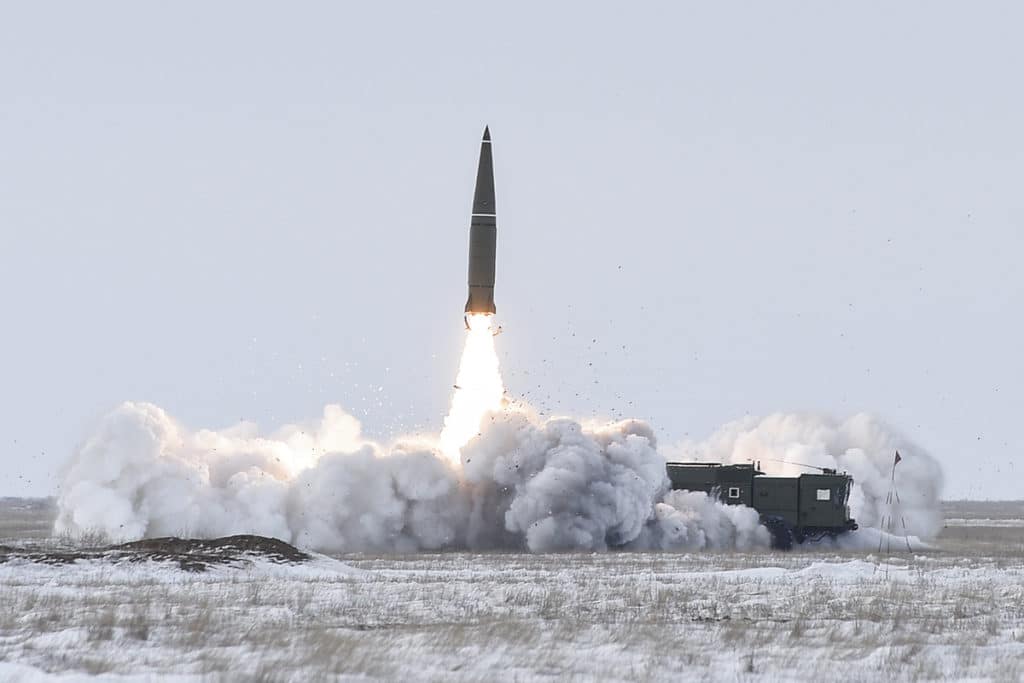The Russian Defense Ministry (MoD) announced that a ship carrying European ammunition was destroyed by an Iskander-M missile in the port of Yuzhny, located in Ukraine’s Odesa region.
According to a statement from the Russian Defense Ministry, the attack took place on October 6 while the ship was unloading its cargo.
The Iskander-M short-range ballistic missile successfully hit the transport vessel as it docked at Yuzhny Seaport, situated approximately 30 kilometers east of Odessa.
“The missile strike was carried out at the moment of unloading. The objective control footage shows the detonation of the ammunition,” Russian officials reported.
While the exact origin of the shipment and the volume of weapons destroyed were not disclosed, Russia claimed the arms had arrived from Europe.
Drone footage released by the Russian Defense Ministry shows a missile hitting the ship, followed by flames engulfing the vessel. The footage, filmed from a high altitude, captures the explosion and the subsequent fire.
🚨 **BREAKING: Massive Strike on Odessa's Yuzhny Port!**
Tonight, Russian forces launched a powerful attack on the Yuzhny port in the Odessa region, hitting ammunition and military supplies during unloading. A dramatic Iskander missile strike even targeted a container ship… pic.twitter.com/gWI5g5gDcE
— Agentis GeoP 🇷🇸🇷🇺☦️ (@AgentisGeop) October 6, 2024
Ukraine, however, provided a different account of the incident. Oleg Kiper, head of the Odessa regional administration, downplayed the damage, stating that the missile had hit what he described as a “civilian vessel” and asserted that no injuries had been reported.
Nevertheless, Ukraine’s State Emergency Service noted that one person was wounded during the attack and that cargo trucks and warehouses in Odesa sustained damage.
In addition to the missile strike, Russian forces unleashed a multi-wave drone attack across Ukraine, targeting Kyiv and infrastructure in the Black Sea port of Odesa.
According to Ukraine’s air force, 56 of at least 87 drones launched by Russia were shot down, while another 25 were reportedly “lost” due to electronic jamming.
Iskander-M Missile
Russia has been increasingly relying on its Iskander-M missile system, a powerful short-range ballistic missile capable of carrying up to 700 kilograms of explosives over a distance of 500 kilometers.
These missiles have become a key component in targeting vital Ukrainian military infrastructure, including staging areas for troops and critical supply routes used for the transportation of Western arms and equipment.
In particular, Ukraine’s coastal regions and ports have come under frequent attack due to their crucial role in receiving foreign military aid.
By focusing on these strategically important areas, Russia is aiming to disrupt the flow of Western support, weakening Ukraine’s defensive capabilities and hindering its ability to sustain its military operations over the long term.
The Iskander-M missile system, with a range of up to 400-500 km, has proven to be a crucial asset for Russia, effectively deployed in various conflicts such as the Syrian Civil War and the ongoing war in Ukraine.

The Iskander uses a single-stage solid rocket propellant and can achieve hypersonic velocities during its terminal phase as it re-enters the atmosphere. This capability poses significant challenges for defense systems, as intercepting hypersonic missiles is difficult.
In February, reports indicated that Russia was rapidly implementing upgrades to the Iskander system to improve its lethal capabilities. This investment demonstrates Moscow’s commitment to making one of its most potent strike weapons even more formidable.
The Iskander missiles, equipped with advanced guidance systems, attain a high degree of targeting precision. These systems incorporate inertial navigation, optical targeting, and satellite-assisted guidance, enhancing their effectiveness on the battlefield.
Throughout the ongoing conflict, the Iskander missile system has demonstrated its effectiveness.
On March 5, 2024, Russian forces achieved a significant victory by using an Iskander ballistic missile to destroy an M142 HIMARS system near Nykanorivka in Donetsk Oblast. That was the first time a HIMARS had been destroyed in Ukraine after nearly two years of attempts.
Just days later, on March 9, an Iskander missile was used to destroy two German-supplied M901 launchers for the MIM-104 Patriot air defense system near Pokrovsk, marking the first destruction of Patriot components in the conflict.
In early July 2024, Russian forces launched a series of attacks using Iskander missiles on Ukrainian airbases. Prior aerial reconnaissance conducted with drones facilitated these strikes, which destroyed multiple Ukrainian military aircraft.
Moreover, Russia has positioned these missile systems within its Baltic Sea enclave of Kaliningrad, strategically located between Germany and Poland.
This deployment has not only strengthened Russia’s defense of this vulnerable territory but also serves as a stark warning to European nations about the potential consequences of the Ukraine War escalating further.
- Contact the author at ashishmichel(at)gmail.com
- Follow EurAsian Times on Google News




